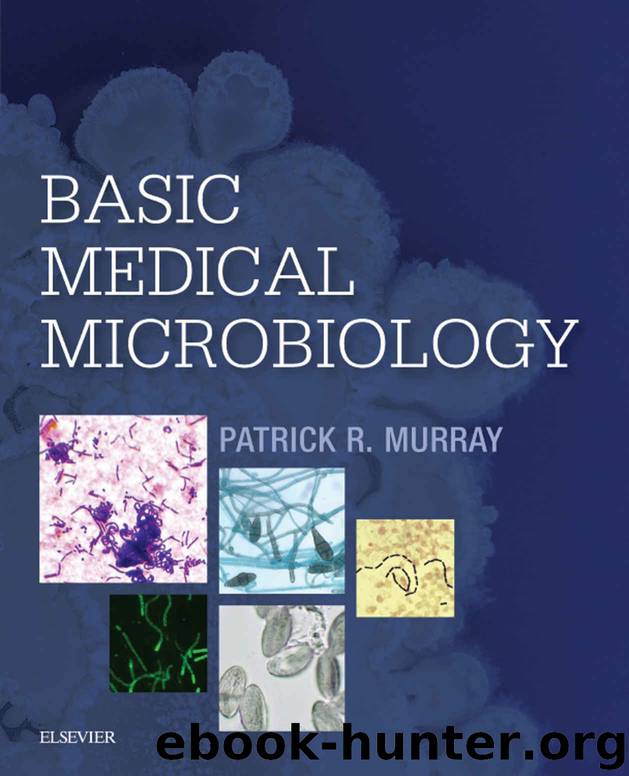Basic Medical Microbiology E-Book by Patrick R. Murray

Author:Patrick R. Murray
Language: eng
Format: mobi
ISBN: 9780323478526
Publisher: Elsevier Health Sciences
Published: 2017-02-19T16:00:00+00:00
Rotavirus
Rotavirus was the first virus demonstrated to cause human gastrointestinal disease by observing large numbers of viral particles in the stool of symptomatic children. Despite the recognition of the importance of this virus and the introduction of vaccines to control spread of the pathogen, rotaviruses are still the most common cause of viral diarrhea in most countries.
Rotavirus
Clinical Case
Severe Rotavirus Infection in an Infant
Bharwani and colleagues1 described a 10-month-old infant who developed a severe rotavirus infection. The previously healthy girl presented to the hospital emergency department with two brief generalized tonic-clonic convulsions after 2 days of vomiting, diarrhea, and a low-grade fever. Upon arrival her blood pressure was 102/54 mmHg, heart rate was 150 beats/minute, respiratory rate was 34 breaths/minute, body temperature was 37.8°C and oxygen saturation was 94% on room air. She was lethargic and dehydrated. Blood tests revealed hyponatremia, hypoproteinemia, leukocytosis, and thrombocytosis. After initial stabilization (hydration, correction of electrolyte imbalances, seizure control), bacterial cultures of blood, cerebrospinal fluid, and urine were performed (all were negative). Over the next 24 hours the patient developed generalized edema with ascites and pleural effusion. Because of labored breathing, dyspnea, and continued acidosis, the patient was transferred to the intensive care unit where thoracentesis was performed to relieve the accumulated fluids. Stool tested positive for red and white blood cells and for rotavirus; no bacterial pathogens were recovered. Methylprednisolone was administered on day 4 due to persistent hypoalbuminemia and on day 6 because the patient was tachycardiac and hypotensive. Blood tests showed neutropenia, thrombocytopenia, anemia, and coagulopathy, with increased prothrombin and partial prothrombin times. Bacterial cultures remained negative throughout the hospitalization, and over the next 2 weeks the patient gradually improved. The infant was fully recovered at follow-up at 2 months postdischarge. This case demonstrates a severe episode of rotavirus infection that would have been fatal without the aggressive medical support that was available. This is a reminder that rotavirus is responsible for many of the fatalities associated with infant diarrhea.
Download
This site does not store any files on its server. We only index and link to content provided by other sites. Please contact the content providers to delete copyright contents if any and email us, we'll remove relevant links or contents immediately.
| Cell Biology | Developmental Biology |
| Entomology | Marine Biology |
| Microbiology | Molecular Biology |
| Biostatistics |
Sapiens: A Brief History of Humankind by Yuval Noah Harari(14312)
The Tidewater Tales by John Barth(12625)
Mastermind: How to Think Like Sherlock Holmes by Maria Konnikova(7275)
Do No Harm Stories of Life, Death and Brain Surgery by Henry Marsh(6904)
The Thirst by Nesbo Jo(6877)
Why We Sleep: Unlocking the Power of Sleep and Dreams by Matthew Walker(6651)
Life 3.0: Being Human in the Age of Artificial Intelligence by Tegmark Max(5506)
Sapiens by Yuval Noah Harari(5321)
The Longevity Diet by Valter Longo(5039)
The Body: A Guide for Occupants by Bill Bryson(5027)
The Rules Do Not Apply by Ariel Levy(4907)
The Immortal Life of Henrietta Lacks by Rebecca Skloot(4548)
Animal Frequency by Melissa Alvarez(4424)
Why We Sleep by Matthew Walker(4394)
The Hacking of the American Mind by Robert H. Lustig(4336)
Yoga Anatomy by Kaminoff Leslie(4331)
All Creatures Great and Small by James Herriot(4267)
Double Down (Diary of a Wimpy Kid Book 11) by Jeff Kinney(4240)
Embedded Programming with Modern C++ Cookbook by Igor Viarheichyk(4137)
